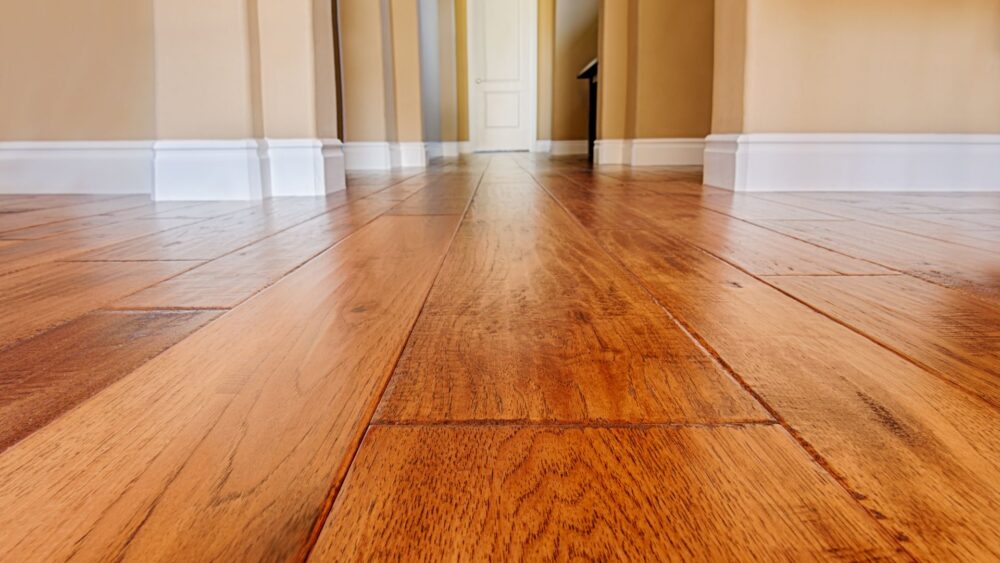Keeping your home’s hardwood floors in tip-top shape might seem like a chore, but it doesn’t have to be. With the right approach, maintaining those gleaming wood surfaces can become as routine as making your morning coffee. From tackling dirt and grime to ensuring they shine like new, hardwood floor maintenance is all about smart care and prevention. Whether you’re dealing with dust bunnies or unexpected spills, we’ve got the lowdown on keeping things pristine without breaking a sweat.
Preventive Maintenance for Hardwood Floors
Hardwood floors bring a touch of elegance to any space, yet they do need a bit of pampering to stay in tip-top shape. The good news? Taking a bit of time for some upkeep now can really save your investment down the line.
Regular Vacuuming and Sweeping
The first line of defense against dirt, dust, and debris is regular vacuuming and sweeping. Make it a habit to sweep and vacuum your hardwood floors at least once a week, using a soft-bristle attachment to avoid scratching the surface. For those hard-to-reach corners and crevices, a microfiber mop can work wonders. Just be sure to avoid using a wet mop, as excess moisture can damage wood floors over time.
Mopping with Appropriate Cleaners
When it comes to cleaning hardwood floors, less is more. Stick to pH-neutral cleaners specifically designed for wood floors, and avoid harsh chemicals that can strip away the finish. A simple solution of warm water and a few drops of dish soap can work well for spot cleaning. Just remember to wring out your mop thoroughly before applying it to the floor, and dry any excess moisture with a clean cloth. Water is the enemy of hardwood floors. Whether it’s a spill, a leak, or high humidity levels, excess moisture can cause wood to warp, cup, or even rot over time. To protect your floors, wipe up spills immediately and avoid using a wet mop for regular cleaning. If you live in a humid climate, consider investing in a dehumidifier to keep moisture levels in check.
Placing Mats and Rugs in High-Traffic Areas
High-traffic areas like entryways, hallways, and kitchens are prone to wear and tear. To minimize damage, place mats and rugs in these areas to catch dirt, debris, and moisture before it reaches your hardwood floors. Look for mats with a non-slip backing to prevent accidents, and choose rugs made from natural materials like wool or cotton to allow your floors to breathe.
Renewing and Repairing Hardwood Floors
Even with the best preventive maintenance, hardwood floors will eventually show signs of wear and tear. But don’t despair – with a little elbow grease and the right techniques, you can bring your floors back to life. The first step in renewing your hardwood floors is identifying the signs of wear and tear. Look for scratches, dents, and discoloration, as well as areas where the finish has worn away. If you notice any loose or squeaky boards, it may be time to call in a professional for repairs. Sweeping these problems under the rug now might just invite bigger headaches later on.
Sanding and Refinishing Techniques
For floors with extensive damage, sanding and refinishing may be necessary. So, what you’re doing here is stripping off that old finish and giving the wood a good sanding until it’s silky smooth and perfectly even. Now, if you’re someone who knows their way around a toolbox, diving into this project on your own could be right up your alley. Just be sure to use the proper equipment and techniques to avoid damaging your floors further. For best results, consider hiring a professional flooring contractor. Water damage is a serious issue for hardwood floors. If left untreated, it can lead to warping, cupping, and even mold growth. If you notice water damage on your floors, act quickly to remove any standing water and dry the area thoroughly. You may need to use fans or dehumidifiers to speed up the drying process. For severe damage, you may need to replace individual boards or even the entire floor. A professional can assess the extent of the damage and recommend the best course of action.
Filling Gaps and Cracks
Over time, hardwood floors may develop gaps and cracks due to changes in humidity and temperature. These gaps not only detract from the appearance of your floors but can also allow dirt and debris to accumulate. To fill gaps and cracks, use a wood filler that matches the color of your floors. Apply the filler with a putty knife, smoothing it out to create an even surface. Once dry, sand the area lightly to blend it in with the surrounding wood.
Hiring a Professional for Major Repairs
For major repairs like replacing boards or addressing water damage, it’s best to hire a professional. A skilled flooring contractor will have the tools, expertise, and experience needed to get the job done right. When hiring a professional, look for someone with experience working with hardwood floors and a track record of satisfied customers. Don’t be afraid to ask for references or to see examples of their previous work.
Cleaning Products for Hardwood Floors
Choosing the right cleaning products is essential for maintaining the beauty and longevity of your hardwood floors. With so many options on the market, it can be tough to know where to start. When it comes to cleaning hardwood floors, pH-neutral cleaners are your best bet. These cleaners are specifically designed to be gentle on wood surfaces, without stripping away the finish or leaving behind residue. Look for cleaners that are labeled as “safe for hardwood floors” or “pH-neutral.” Avoid cleaners that contain harsh chemicals like ammonia or bleach, which can damage the wood over time.
Avoiding Harsh Chemicals
Harsh chemicals like vinegar, ammonia, and bleach may seem like a quick fix for tough stains and grime, but they can actually do more harm than good when it comes to hardwood floors. These chemicals can strip away the finish, leaving your floors vulnerable to damage and discoloration. They can also leave behind a residue that attracts dirt and debris, making your floors harder to keep clean in the long run. If you prefer a more natural approach to cleaning, there are plenty of DIY solutions you can try. One simple recipe is to mix equal parts white vinegar and water in a spray bottle, then use a microfiber mop to apply the solution to your floors. Another option is to mix a few drops of mild dish soap with warm water in a bucket, then use a damp mop to clean your floors. Just be sure to wring out the mop thoroughly to avoid leaving excess water on the surface.
Recommended Commercial Products
If you prefer the convenience of store-bought cleaners, there are plenty of options to choose from. Some popular brands include Bona, Murphy’s Oil Soap, and Method. When you’re out there hunting for cleaning supplies, make sure to snag those cleaners that are made with hardwood floors in mind. Avoid all-purpose cleaners or those that contain wax or oil, as these can leave behind a residue that attracts dirt and debris.
Removing Stains from Hardwood Floors
No matter how careful you are, accidents happen. Whether it’s a spilled glass of wine or a pet stain, knowing how to remove stains from your hardwood floors is essential for keeping them looking their best.
Identifying Stain Types
The first step in removing a stain is identifying what type of stain it is. Common types of stains include:
- Water stains
- Pet stains
- Food and drink stains
- Oil-based stains
- Ink stains
Each type of stain requires a different approach to removal, so it’s important to identify the stain before attempting to clean it.
Removing Dark Spots and Pet Stains
Dark spots and pet stains can be particularly stubborn, but with the right approach, they can be removed. Here are a few tips:
- Blot the stain with a clean, damp cloth to remove as much of the liquid as possible.
- Mix a solution of one part white vinegar and one part water in a spray bottle, then apply it to the stain.
- Let the solution sit for a few minutes, then blot it up with a clean cloth.
- Repeat the process until the stain is gone.
For particularly stubborn stains, you may need to use a commercial cleaner designed for pet stains. Just be sure to test the cleaner on an inconspicuous area first to ensure it won’t damage the finish.
Eliminating Heel Marks
Heel marks are a common problem on hardwood floors, especially in high-traffic areas. If you’re looking to get rid of them, here’s what you can try:
- Rub the mark with a clean, dry cloth to remove any loose dirt or debris.
- Apply a small amount of mineral spirits to a clean cloth, then rub the mark gently.
- Wipe the area with a damp cloth to remove any residue.
- Buff the area with a dry cloth to restore the shine.
If the mark is particularly stubborn, you may need to use a commercial cleaner designed for removing scuff marks. Just be sure to follow the manufacturer’s instructions carefully.
Treating Oil-Based Stains
Oil-based stains like cooking oil or makeup can be particularly challenging to remove from hardwood floors. Here are a few tips:
- Blot the stain with a clean, dry cloth to remove as much of the oil as possible.
- Sprinkle baking soda or cornstarch on the stain, then let it sit for several hours to absorb the oil.
- Vacuum up the powder, then wipe the area with a damp cloth.
- If the stain persists, try rubbing it gently with a cloth dampened with mineral spirits.
For particularly stubborn oil-based stains, you may need to sand the area lightly and refinish it to blend it in with the surrounding wood.
Addressing Watermarks and White Stains
All sorts of things, from accidental spills to the stickiness of high humidity, can leave those pesky watermarks and white stains behind. If you’re looking to get rid of them, here’s what you can try:
- Rub the stain with a clean, dry cloth to remove any loose dirt or debris.
- Mix equal parts white vinegar and olive oil in a bowl, then apply the mixture to the stain with a clean cloth.
- Rub the mixture into the stain in a circular motion, then let it sit for several hours.
- Wipe the area with a clean, damp cloth to remove the mixture, then buff it dry with a clean cloth.
If the stain persists, you may need to use a commercial cleaner designed for removing watermarks and white stains. Just be sure to follow the manufacturer’s instructions carefully.
Maintaining Hardwood Floors in High-Traffic Areas
High-traffic areas like entryways, hallways, and kitchens can take a beating when it comes to hardwood floors. But with a few simple strategies, you can keep these areas looking their best for years to come. One of the easiest ways to protect your hardwood floors in high-traffic areas is to place doormats and area rugs at all entrances. This handy trick acts like a superhero, trapping dirt, debris, and moisture before they even have the chance to get cozy with your floors. Look for mats and rugs with a non-slip backing to prevent accidents, and choose materials that are easy to clean and maintain. Natural materials like wool and cotton are a good choice, as they allow your floors to breathe and prevent moisture buildup.
Encouraging Family Members to Remove Shoes
Another simple way to protect your hardwood floors in high-traffic areas is to encourage family members and guests to remove their shoes before entering your home. Doing this can really cut down on the dirt, debris, and moisture that ends up getting tracked inside from the outdoors. Consider placing a shoe rack or basket near the entrance to make it easy for people to remove and store their shoes. Why not up the coziness factor for your guests by offering them slippers or house shoes to pad around in while they’re inside? When it comes to those annoying scratches and dents that show up on your hardwood floors, often the main culprits are pieces of furniture in spots where there’s a lot of foot traffic. To minimize damage, consider placing felt pads or furniture glides under the legs of chairs, tables, and other furniture. By simply adding these little tweaks, you can kiss goodbye to scratches and dents because your furniture will now slide across the floor as smooth as butter. Just be sure to replace the pads or glides periodically, as they can wear down over time.
Cleaning High-Traffic Areas More Frequently
Finally, one of the best ways to maintain hardwood floors in high-traffic areas is to clean them more frequently than other areas of your home. This will help prevent dirt, debris, and moisture from building up and causing damage over time. Aim to sweep or vacuum high-traffic areas at least once a day, and mop them with a pH-neutral cleaner once a week. For particularly stubborn stains or scuff marks, you may need to use a commercial cleaner designed for hardwood floors. By following these simple strategies, you can keep your hardwood floors looking beautiful and pristine, even in the busiest areas of your home.
FAQs in Relation to Hardwood Floor Maintenance
How often do you need to seal hardwood floors?
You should reseal them every 3-5 years, depending on foot traffic and wear.
How often should you polish hardwood floors?
Polishing is best done every 2-4 months to keep that shine bright.
How do you care for finished hardwood floors?
Sweep daily, mop weekly with a pH-neutral cleaner, and avoid water puddles. Simple yet effective.
Are hardwood floors high maintenance?
Nope. Regular cleaning and the occasional deep-care session keep them in top shape without much fuss.
Conclusion
Maintaining Your Floors Shouldn’t Be a Chore
So there you have it—maintaining those beautiful hardwood floors of yours isn’t rocket science; it’s just good housekeeping! It boils down to vacuuming away life’s little messes and mopping up without drenching them in water. Remember that time when we found out using too much liquid could be their arch-nemesis? Who knew!
In all seriousness though, taking these simple steps ensures your flooring stays looking its best year after year—a testament to both beauty and durability underfoot.





